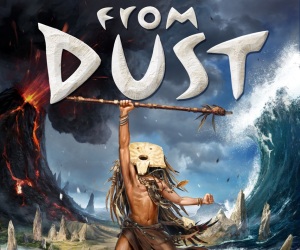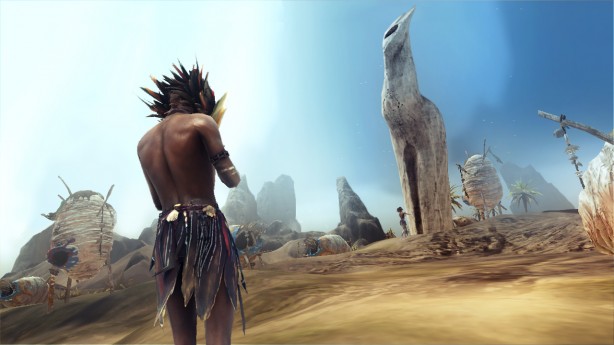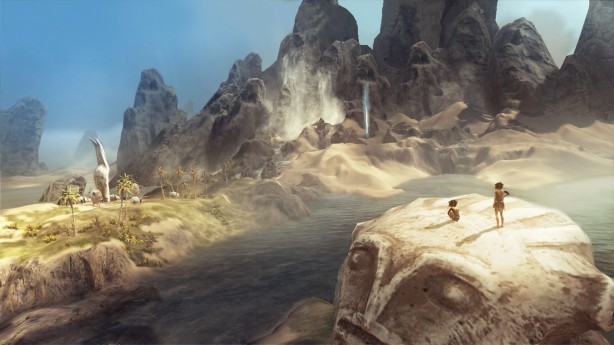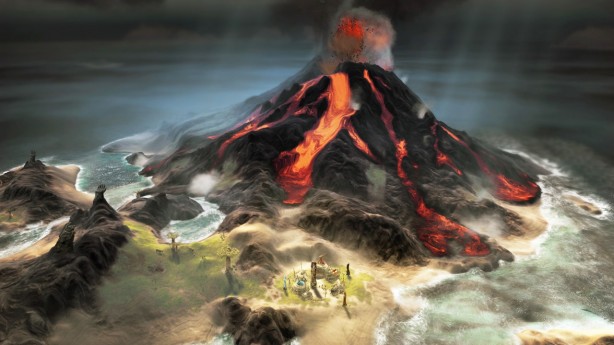From Dust Review
 Game: From Dust
Game: From Dust
Developer: Ubisoft Montpellier
Publisher: Ubisoft
Available on: PC, Xbox 360, PlayStation 3 (Xbox 360 Version Reviewed)
Taking cues from “tribal” God games such as Populous and Black & White, From Dust puts players in control of a prehistoric world and its people. However, unlike previous examples of the genre, From Dust does not allow the player to reign over civilization. Instead, it gives players power over the land itself, letting them manipulate the land and sea in the hopes of giving the tiny tribespeople a safe place to live. Tsunamis, volcanoes and bush fires threaten the human villages, and it’s up to the player to transform the landscape so that the people survive.

STORY: The game follows a nameless nomadic tribe making their way between various islands in search of home and enlightenment. Scattered throughout the world are totems, some of which hold the key to long-lost knowledge which the tribe must gain if they are to survive the onslaught of the elements. At the beginning of the game, the tribe invoke the power of The Breath, a god who has power over the environment, and ask for its help in guiding them through the hostile land.
As The Breath, you are responsible for leading the people through the world, and shaping it for them so that it can support life. Able to suck up and hold quantities of various elements (water, earth, lava and some plants), The Breath can mould the landscape and summon the tribespeople to the totems. As the tribespeople gain knowledge and reproduce, The Breath grows stronger.
GRAPHICS: From Dust is an absolutely stunning game. The textures of the different elements are richly coloured and beautifully textured, and the water especially will make you want to go swimming. The Breath appears as a tube of light which skims over the landscape smoothly, regardless of how rough the terrain is. When it sucks up the elements, the substance in question appears in a swirling ball above The Breath, which can then be trickled slowly down into place. As you would hope, different elements fall in different ways. Whilst water splashes down into a puddle, earth forms a shifting pile, and lava solidifies quickly.
The behaviour of the different elements makes the world feel solid and dynamic, a feeling amplified by the fact that the world changes as each level progresses. The tribal villages grow and develop, with mushroom-like pods springing up from the ground, and strings of flags stretching from village to village. Although the earth is initially barren, if you introduce water, it begins to grow green and lush, sprouting foliage and palm trees. Whilst the tribespeople themselves look very much alike, this doesn’t matter as you will spend much of the game with the camera suspended so far above them that they rarely appear bigger than ants.

SOUND: The sound design in From Dust is nothing revolutionary, and if you’ve played anything remotely similar than the tribal instruments will sound instantly familiar. The tribespeople mumble made-up words, and scream in terror when their villages are threatened by various natural disasters. As the settlements grow, you’ll start to hear the introduction of more instruments, which is a nice touch, but the sound is only ever a backdrop to the spectacular graphics.
GAMEPLAY: The simplicity of From Dust’s premise and control scheme belies a deceptively tricky strategy puzzler that lurks within. The first few levels are gentle, easing you into the beautiful world with some simple tasks. At first, all you’re able to do is suck up quantities of earth and water, and transfer them to other areas of the landscape in order to create land bridges and dry areas for the tribespeople to navigate and build upon. But as you guide the tribespeople to more totems, you obtain more powers, and you’ll eventually be able to change the properties of water, increase the capacity and speed of The Breath, and cause the evaporation of all liquid on the map.
Of course, as you become more powerful, the environment becomes more hostile, and you’ll need to carefully consider how best to deploy these powers if you’re going to prevent the tribespeople being washed away by floods, destroyed by volcanic eruptions, or burned to death in a bush fire. In general, you must have at least five tribespeople alive at any one time, and although they reproduce quickly (levels will usually end with hundreds in play), they die quickly too. Lose too many, and it’s back to the beginning of the level. The levels get longer as the game progresses too, meaning that you’ll need to be vigilant if you’re going to prevent an hour’s careful work being washed away by a tsunami.
As you uncover new totems and village sites, you’ll need to create paths for the tribespeople so that they can reach them and learn (or teach you) their powers. Sometimes you’ll need to build sturdy rock walls with lava to shield settlements from waves, whilst other situations will require you to divert a river to halt a spreading fire. Although there are some points (generally near the beginning of the game) where the method is obvious, later levels will require some lateral thinking and a great deal of forward planning. The game elements get steadily more complex, and you’ll eventually need to uproot certain plants which emit fire, water or explosions in order to protect your people or create new paths. The aptly-named “Challenge Mode” will test even the most confident players, and makes full use of the various mechanics on show.

Yet despite From Dust’s solid puzzle core, the game’s greatest joy comes from simply playing with the landscape. Watching how the different substances interact with each other is a tactile joy, and slowly dropping a large quantity of water onto the top of a mountain is delightful. What’s more, the landscape gradually changes over time, so your actions have both long-term and short-term consequences. Diverting the course of a vast river will make a village safe, but it will also slowly erode both the earth below it and, at a slower rate, the harder rock beneath.
Further to this, allowing water to remain in close proximity to land will result in a gradual spread of lush foliage which eventually makes the earth more stable. If you allow the greenery to proliferate for long enough, strange creatures will eventually make their way on to the landscape. Watching these features grow alongside the tribespeople’s developing villages is an absolute joy, and the slow transformation of the landscape is one of From Dust’s greatest strengths.
LONGEVITY: The story mode will last for around six hours and once finished, demands a second play-through, if only so you can spend more time diverting the course of rivers and watching the long-term effects of your actions. A nice feature is the fact that you are rewarded for spreading plant life across the land by having more of the world’s background revealed to you, which encourages you to take a slower, more leisurely approach to gameplay. From Dust is so utterly delightful that you will want to return to it again and again, just to see how the landscape differs each time. Along with the addition of a hefty Challenge Mode, this is a game that has plenty of mileage.
VERDICT: From Dust gives new meaning to the term “sandbox”. Although it is possible (especially in the later levels) to experience a frustrating “Game Over”, this can be avoided with careful planning, leaving you free to play with the world. Ubisoft said that they wished to recreate the feeling of “building sandcastles at the beach”, and with From Dust, they have achieved this in a vivid, tactile way. The game’s strategic elements are challenging without being unfair, and are deep enough to warrant multiple attempts, just to see whether things could have played out differently. The care and attention to detail in its execution is matched by the depth of its puzzles, making this one of the best-value games on the download market. A fresh take on an old genre, From Dust is a beautiful triumph.





